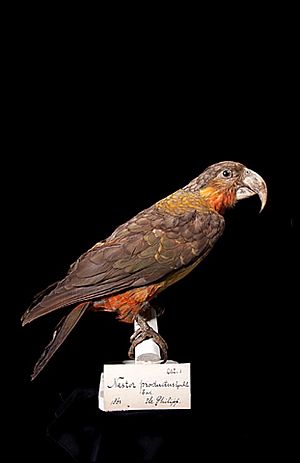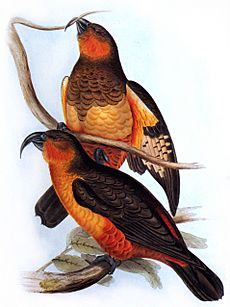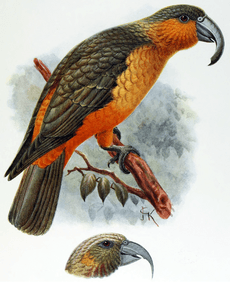Norfolk kākā facts for kids
Quick facts for kids Norfolk kākā |
|
|---|---|
 |
|
| Naturalis Biodiversity Center's taxidermed Norfolk kākā | |
| Conservation status | |
| Scientific classification | |
| Genus: |
Nestor
|
| Species: |
productus
|
| Synonyms | |
|
Nestor norfolcensis |
|
The Norfolk kākā (Nestor productus) was a large parrot that is now extinct. It belonged to the parrot family Nestoridae. These birds were about 38 centimeters (15 inches) long. They had mostly olive-brown feathers on their upper bodies. Their cheeks and throat were reddish-orange, and their chests were straw-colored. Their thighs, rump, and lower belly were dark orange. They also had a large, noticeable beak.
The Norfolk kākā lived on the rocks and in the tall trees of Norfolk Island and nearby Phillip Island. It was a close relative of the New Zealand kākā.
Contents
Discovering the Norfolk Kākā
The Norfolk kākā was first written about by naturalists Johann Reinhold Forster and his son Georg. This happened after James Cook discovered Norfolk Island on October 10, 1774. However, their description was not published until 1844.
Around 1790, John Hunter drew a picture of the bird. It was sitting on a plant called a kangaroo apple. The bird was officially named by John Gould in 1836. He used a bird specimen from the Zoological Society of London for his description.
At first, people thought the birds from Norfolk Island and Phillip Island were different species. But after comparing specimens from both islands, scientists realized they were the same species.
Life and Habits
Not much is known about how the Norfolk kākā lived. People said it spent time both on the ground and in tall trees. It ate from flowering shrubs and trees.
John Gould described the bird's call as a "hoarse, quacking, inharmonious noise." He also said it sometimes sounded like a dog barking.
Why the Norfolk Kākā Disappeared
The Polynesians lived on Norfolk Island before Europeans arrived. They hunted the kākā for food. The Polynesians left the island around the 1600s.
When the first European settlers arrived in 1788, they also hunted the kākā for food. They also caught the birds to keep as pets. The bird's population suffered a lot when a penal colony (a prison settlement) was on the island. This colony was there from 1788 to 1814, and again from 1825 to 1854.
The Norfolk kākā likely became extinct in the wild during the time of the second penal colony. An officer named Abel D. W. Best did not see any kākās in his diary entries from 1838-1839. He was collecting bird specimens, so if the kākā was still around, he probably would have written about it. The very last Norfolk kākā in captivity died in London in 1851.
Surviving Specimens

Today, at least 16 specimens (preserved birds) of the Norfolk kākā still exist in museums around the world. These specimens help scientists learn about the extinct bird.
Many of these specimens are held in museums like the Australian Museum in Sydney, Museum Victoria in Melbourne, and the American Museum of Natural History in New York City. The Naturalis Biodiversity Center in Leiden, Netherlands, has two skins. One of these skins was acquired in 1863, long after the bird was thought to be extinct.
See also
 In Spanish: Kaka de la Isla Norfolk para niños
In Spanish: Kaka de la Isla Norfolk para niños



